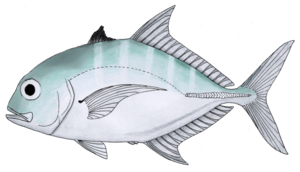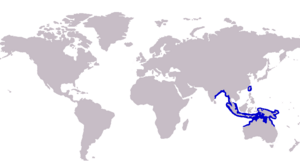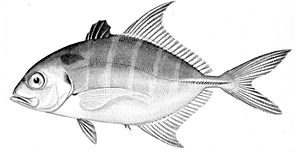Duskyshoulder trevally facts for kids
Quick facts for kids Duskyshoulder trevally |
|
|---|---|
 |
|
| Conservation status | |
| Scientific classification | |
 |
|
| Known range of the duskyshoulder trevally | |
| Synonyms | |
|
The duskyshoulder trevally (Carangoides humerosus) is a small ocean fish. It is also called the epaulet trevally. This fish belongs to the jack family, known as Carangidae.
You can find this fish in the eastern Indian Ocean and the western Pacific Ocean. Its home ranges from eastern India to northern Australia and Taiwan. The duskyshoulder trevally is a small fish. It grows to about 27 centimeters long. You can easily spot it by the big, black spots on its shoulders.
This fish lives close to shore in waters less than 50 meters deep. It likes sandy areas in bays and on the continental shelf. The duskyshoulder trevally eats other small fish, crabs, and squid. We don't know much about how it reproduces. This fish is not very important for fishing. It is often caught by accident when people are fishing for prawns.
Taxonomy and Naming
The duskyshoulder trevally is part of a group of fish called Carangoides. These fish are often known as jacks or trevallies. The Carangoides group is in the larger jack and horse mackerel family, called Carangidae. This family is part of the order Carangiformes.
An Australian fish expert, Allan Riverstone McCulloch, first described this fish in 1915. He studied a fish specimen found near Bustard Head in Queensland, Australia. He first named the fish Caranx humerosus. The name "humerosus" means "having shoulders" in Latin. This refers to the fish's dark shoulder spots.
Later, the fish was moved to the Carangoides group, where it still belongs today. It's quite rare for a fish not to be renamed by other scientists. The common name 'duskyshoulder trevally' also points to its dark shoulder markings. The name 'epaulet trevally' means the same thing.
Description
The duskyshoulder trevally is one of the smallest fish in its group. It only grows to about 27 centimeters long. Its body shape is flat and oval, like many other jacks. The top of its body is more rounded than the bottom.
The head of the fish slopes gently. Older male fish might have a small bump on their head. Both jaws have many small teeth. Older fish also have some bigger teeth on the outside. This fish has two separate back fins. The first fin has eight stiff spines. The second fin has one spine and 20 to 22 soft rays.
The fin on its belly has two separate spines at the front. After these, it has one spine and 17 to 19 soft rays. The soft back fin is curved, about the same length as its head. The side line of the fish is slightly curved at the front. This curved part has 62 to 72 scales. The straight part has three to eight scales and 24 to 32 tough plates called scutes.
The chest of the duskyshoulder trevally has no scales. This smooth area goes up to behind its belly fins. It also extends to the base of its side fins. The fish has six to 10 gill rakers on its first gill arch. It has 16 to 20 on its second gill arch. This species has 24 bones in its spine, called vertebrae.
The duskyshoulder trevally is dark green on top. This color fades to silver on its belly. Adult and young fish often have five or six dark stripes down their bodies. A large black spot is usually on its shoulder. Smaller dark spots are on its gill cover and near its side fin. The soft back fin, belly fin, and tail fin are dark. The spiny back fin is black. The side and belly fins are clear or white.
Distribution and Habitat
The duskyshoulder trevally lives in warm parts of the eastern Indian Ocean and western Pacific Ocean. It has been found along the coasts of India, Indonesia, Papua New Guinea, northern Australia, and possibly Taiwan. It likely lives around more islands in this area. However, scientists have not yet recorded it there.
This fish lives in waters that are shallower than 50 meters. It usually prefers sandy areas and reefs on the continental shelf. It also swims into bays. You can find it near beaches and in creeks lined with mangrove trees.
Biology and Fishery
Scientists have not studied the duskyshoulder trevally very much. We know most about what it eats. This fish is a benthic predator. This means it hunts and eats creatures that live on the seafloor. Studies in the Gulf of Carpentaria show it mainly eats small fish and crabs. It especially likes a type of crab called brachyurans.
Sometimes, it also eats prawns, other crustaceans, snails, and squid. We don't know anything about how this fish moves around. We also don't know how it reproduces.
The duskyshoulder trevally is not very important for commercial fishing. It is also not a popular fish for people who fish for fun. However, it is often caught by accident in other fishing nets. This happens a lot in the prawn fishing industry in northern Australia. When caught, these fish are usually thrown back into the ocean. They are rarely sold in markets.
See also
 In Spanish: Carangoides humerosus para niños
In Spanish: Carangoides humerosus para niños



